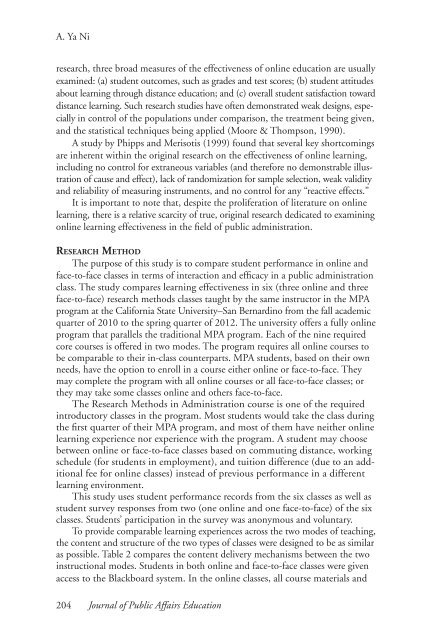Comparing the Effectiveness of Classroom and Online Learning ...
Comparing the Effectiveness of Classroom and Online Learning ...
Comparing the Effectiveness of Classroom and Online Learning ...
You also want an ePaper? Increase the reach of your titles
YUMPU automatically turns print PDFs into web optimized ePapers that Google loves.
A. Ya Ni<br />
research, three broad measures <strong>of</strong> <strong>the</strong> effectiveness <strong>of</strong> online education are usually<br />
examined: (a) student outcomes, such as grades <strong>and</strong> test scores; (b) student attitudes<br />
about learning through distance education; <strong>and</strong> (c) overall student satisfaction toward<br />
distance learning. Such research studies have <strong>of</strong>ten demonstrated weak designs, especially<br />
in control <strong>of</strong> <strong>the</strong> populations under comparison, <strong>the</strong> treatment being given,<br />
<strong>and</strong> <strong>the</strong> statistical techniques being applied (Moore & Thompson, 1990).<br />
A study by Phipps <strong>and</strong> Merisotis (1999) found that several key shortcomings<br />
are inherent within <strong>the</strong> original research on <strong>the</strong> effectiveness <strong>of</strong> online learning,<br />
including no control for extraneous variables (<strong>and</strong> <strong>the</strong>refore no demonstrable illustration<br />
<strong>of</strong> cause <strong>and</strong> effect), lack <strong>of</strong> r<strong>and</strong>omization for sample selection, weak validity<br />
<strong>and</strong> reliability <strong>of</strong> measuring instruments, <strong>and</strong> no control for any “reactive effects.”<br />
It is important to note that, despite <strong>the</strong> proliferation <strong>of</strong> literature on online<br />
learning, <strong>the</strong>re is a relative scarcity <strong>of</strong> true, original research dedicated to examining<br />
online learning effectiveness in <strong>the</strong> field <strong>of</strong> public administration.<br />
Research Method<br />
The purpose <strong>of</strong> this study is to compare student performance in online <strong>and</strong><br />
face-to-face classes in terms <strong>of</strong> interaction <strong>and</strong> efficacy in a public administration<br />
class. The study compares learning effectiveness in six (three online <strong>and</strong> three<br />
face-to-face) research methods classes taught by <strong>the</strong> same instructor in <strong>the</strong> MPA<br />
program at <strong>the</strong> California State University–San Bernardino from <strong>the</strong> fall academic<br />
quarter <strong>of</strong> 2010 to <strong>the</strong> spring quarter <strong>of</strong> 2012. The university <strong>of</strong>fers a fully online<br />
program that parallels <strong>the</strong> traditional MPA program. Each <strong>of</strong> <strong>the</strong> nine required<br />
core courses is <strong>of</strong>fered in two modes. The program requires all online courses to<br />
be comparable to <strong>the</strong>ir in-class counterparts. MPA students, based on <strong>the</strong>ir own<br />
needs, have <strong>the</strong> option to enroll in a course ei<strong>the</strong>r online or face-to-face. They<br />
may complete <strong>the</strong> program with all online courses or all face-to-face classes; or<br />
<strong>the</strong>y may take some classes online <strong>and</strong> o<strong>the</strong>rs face-to-face.<br />
The Research Methods in Administration course is one <strong>of</strong> <strong>the</strong> required<br />
introductory classes in <strong>the</strong> program. Most students would take <strong>the</strong> class during<br />
<strong>the</strong> first quarter <strong>of</strong> <strong>the</strong>ir MPA program, <strong>and</strong> most <strong>of</strong> <strong>the</strong>m have nei<strong>the</strong>r online<br />
learning experience nor experience with <strong>the</strong> program. A student may choose<br />
between online or face-to-face classes based on commuting distance, working<br />
schedule (for students in employment), <strong>and</strong> tuition difference (due to an additional<br />
fee for online classes) instead <strong>of</strong> previous performance in a different<br />
learning environment.<br />
This study uses student performance records from <strong>the</strong> six classes as well as<br />
student survey responses from two (one online <strong>and</strong> one face-to-face) <strong>of</strong> <strong>the</strong> six<br />
classes. Students’ participation in <strong>the</strong> survey was anonymous <strong>and</strong> voluntary.<br />
To provide comparable learning experiences across <strong>the</strong> two modes <strong>of</strong> teaching,<br />
<strong>the</strong> content <strong>and</strong> structure <strong>of</strong> <strong>the</strong> two types <strong>of</strong> classes were designed to be as similar<br />
as possible. Table 2 compares <strong>the</strong> content delivery mechanisms between <strong>the</strong> two<br />
instructional modes. Students in both online <strong>and</strong> face-to-face classes were given<br />
access to <strong>the</strong> Blackboard system. In <strong>the</strong> online classes, all course materials <strong>and</strong><br />
204 Journal <strong>of</strong> Public Affairs Education
















